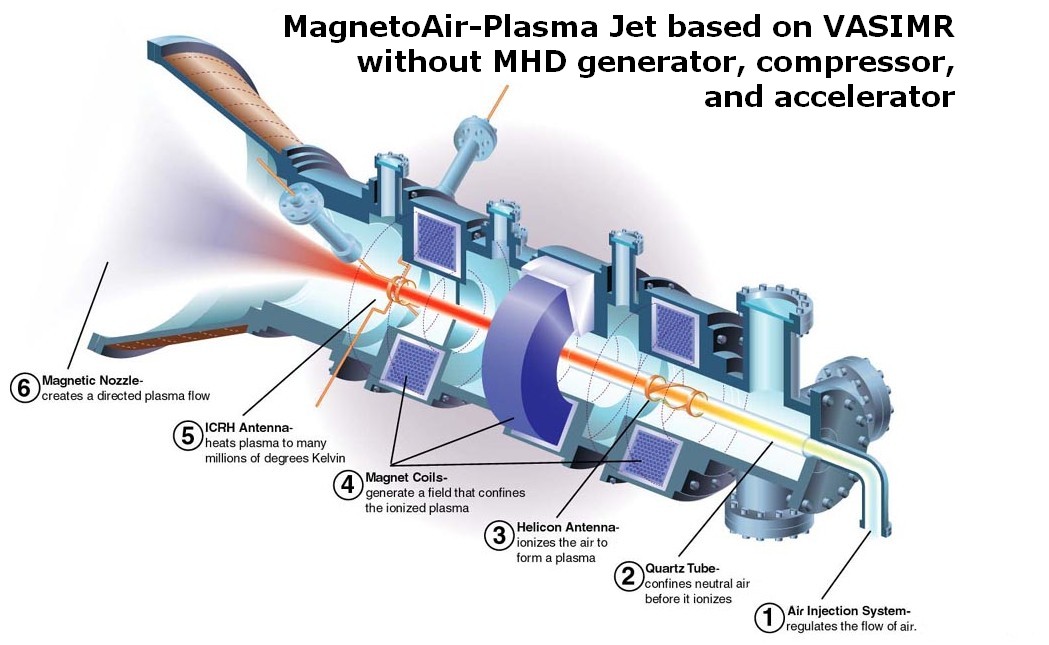 |
|
For realizing our Raylev/Wavelev launch systems, we also have made further developments and inventions of rockets, ramrockets, and air- breathing engines, as well as Rocket-Based Combined Cycle (RBCC), electric, and hybrid powertrains that belong to the field of beamed energy propulsion systems, and are classed as beamed thermal prop- ulsion systems using a
reflecting surface,
rectenna or/and
heat exchanger,
like used with the spacecraft and spaceship class concepts
Rensselaer Polytechnic Institute, United States Air Force (USAF), and National Aeronautics and Space Agency (NASA) Microwave Lightcraft (see also the associated section of the webpage of our spaceship concept XR-3/Lucky Dragon),
Rensselaer Polytechnic Institute, and National Aeronautics and Space Agency (NASA) Laser Lightcraft, and
Style of Speed X3³/Drake class.
In detail, our further developments began in 2008 with making the
Microwave Lightcraft and Laser Lightcraft technologies compatible to the existing aerospace technologies with our spaceship class X3³/ Drake at first, which in the case of beamed thermal propulsion based on a reflecting surface or/and a rectenna with external combustion also comprised
air-breathing plasma engines
- Plasma Ramjets™,
- Plasma Scramjets™ and
- Plasma Dual Mode Ramjets™,
electric powertrains and
hybrid powertrains,
that can be powered by a
- continuous wave laser or/and
- continuous wave maser (microwave),
as well as
aerospike rocket engines, inclusive toroidal and linear versions,
Plasma Rocket™ engines inclusive Plasma Aerospike™ versions,
air-augmented rocket engines, to which belong ramrockets,
air-augmented Plasma Rocket™ engines inclusive Plasma Ram- rocket™ and Plasma RamAerospike™™ versions,
air-breathing engines
- turbofans,
- turbojets,
- ramjets,
- scramjets and
- dual mode ramjets,
air-breathing plasma engines
- Plasma Turbofans™,
- Plasma Turbojets™/Lightturbines™,
air-breathing plasma engines with internal combustion/internal combustor
- Plasma Ramjets™,
- Plasma Scramjets™ and
- Plasma Dual Mode Ramjets™,
electric powertrains with internal thrust generation/internal chamber
and
hybrid powertrains, like
- combined cycle engines and
- combined cycle plasma engines,
that are using as parts of their power systems a
- laser
- repetitive pulsed or
- continuous wave,
or/and
- maser
- repetitive pulsed or
- continuous wave,
and that in the end led by an additional step to plasma engines that can run without beamed energy systems as well, like our
air-augmented (plasma) rockets inclusive Plasma Ramrockets™,
air-breathing (plasma) engines/Plasma Jets™
- Plasma Turbojets™/Lightturbines™,
- Plasma Ramjets™,
- Plasma Scramjets™, and
- Plasma Dual Mode Ramjets™
hybrid powertrains, like combined cycle (plasma) engines
- Active Hypersonic™ Engines,
and also
Multimode Plasma™ Engines (MPEs).
In 2011, further research and development efforts were done by making the
Microwave Lightcraft technology compatible to the existing aero- space technologies that comply with the Style of Speed Space System Standard (S5), to which belong e.g. orbital space planes, space taxis, and crew space capsules by Style of Speed,
adding to the whole field of beamed thermal propulsion by applying a heat exchanger,
air-augmented rocket engines, like ramrockets and ramaerospikes™,
pulse jet engines of the before listed types inclusive pulsed detontation versions,
pulsed detontation rocket engines,
air-breathing engines,
electric powertrains and
hybrid powertrains,
comprising their plasma-based versions as well, that all can be powered by a
- laser
- repetitive pulsed or
- continuous wave,
or/and
- maser
- repetitive pulsed or
- continuous wave,
furthermore
rocket engine versions inclusive toroidal and linear aerospike versions powered by
- repetitive pulsed laser or/and
- repetitive pulsed maser,
and also in the field of laser thermal propulsion with heat exchanger
aerospike versions.
Images
 
Advantages
The advantages of our beamed energy propulsion systems are mani- fold. The most important general advantages are that the engines powered in this way are multimode engines that work:
in the atmosphere and
in space depending on the specific version
and
in the full range of
- high-thrust with low-specific impulse propulsion systems over
- low-thrust with high–specific impulse to even
- high-thrust with high-specific impulse,
which was not possible before.
Due to the reason that conceptually no propellant or only a small amount of it is needed and in this way a vehicle must have either
small tanks only or
no tanks at all,
which again leads to vehicles with desirable features like:
very small, compact engine,
unparalled power-to-weight ratio,
ultra lightweight construction,
highly efficient shape,
extremely fast acceleration,
unbelievable high maximal velocity,
unprecedent environmental friendlyness, and
unrivaled safe operation.
But also transportation systems on earth, like our Raylev transport system and Raylev launch system, in orbit, and in space are made possible in ways that would not be the case with the utilization of other propulsion technologies.
|
|
|



